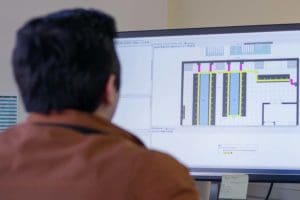Data center planning is a critical aspect of maximising efficiency and minimising operational costs. At EziBlank, we understand that a well-organised data centre not only conserves energy but also enhances overall performance. Our innovative air-flow management solutions, including our signature blanking panels, are designed to streamline your infrastructure, ensuring that your investment goes further. With our easy-to-install systems, you can optimise your data centre’s energy consumption while safeguarding your valuable knowledge assets. Start transforming your data centre today with EziBlank and experience the difference!
Data Center Checklist
A comprehensive data centre checklist is an invaluable tool for ensuring that all critical aspects of data centre management are addressed. This checklist typically covers a wide range of areas, including physical infrastructure, power management, cooling systems, security measures, and network connectivity. Key items might include verifying the integrity of power supply and backup systems, ensuring efficient cooling with proper airflow management and blanking panels, and confirming that all security protocols, such as access controls and surveillance, are in place. Additionally, regular maintenance schedules, disaster recovery plans, and compliance with industry standards should be reviewed and updated. Using a detailed checklist helps data centre managers maintain operational efficiency, minimise downtime, and ensure that the facility is prepared to meet current and future demands.
Read More
Designing an Energy-Efficient Data Center
Designing an energy-efficient data centre requires a strategic approach that combines advanced technology with best practices in layout and infrastructure management. The foundation of an energy-efficient design begins with optimising the physical layout, such as implementing hot and cold aisle containment to prevent the mixing of hot and cold air, which significantly reduces the burden on cooling systems. Incorporating energy-efficient hardware, such as servers and storage devices that consume less power, is also crucial. Additionally, leveraging renewable energy sources like solar or wind power can greatly reduce the carbon footprint of the facility. Effective monitoring and management tools are essential for tracking energy use and making real-time adjustments to improve efficiency. By focusing on these elements, a data centre can achieve optimal performance while minimising energy consumption and operational costs.
Read More
Guide to setting up a Data Center
Setting up a data centre requires careful planning and execution to ensure that the facility meets both current and future needs. The process begins with selecting an appropriate location that offers reliable power, cooling, and connectivity. The physical design of the data centre should incorporate efficient layout strategies, such as hot and cold aisle containment, to optimise airflow and cooling efficiency. Equipping the data centre with scalable infrastructure, including modular server racks and energy-efficient hardware, allows for future growth without major overhauls. Additionally, implementing robust power management systems, such as uninterruptible power supplies (UPS) and backup generators, is critical for ensuring continuous operation. Security measures, both physical and digital, must be in place to protect the data and infrastructure. Finally, ongoing monitoring and maintenance plans should be established to keep the data centre operating at peak performance. By following this guide, you can set up a data centre that is efficient, secure, and scalable.
Read More
